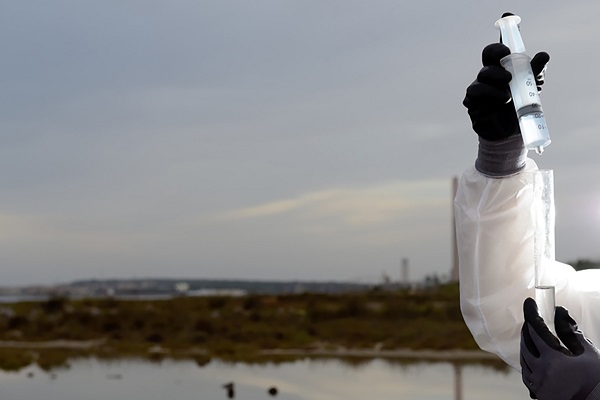Toxins from the tap
As concern grows about groundwater contaminated with potentially harmful compounds known as PFAS, Howard Neukrug, executive director of the Water Center at Penn, offers context about the issue and why it’s so complicated to address.

PFAS, short for per- and poly-fluoroalkyl substances, are an emerging concern as detectable levels have been found in sources of drinking water in Pennsylvania and around the nation.
They’re in furniture and clothes, nonstick pans and pizza boxes. A recent study even found them in chocolate cake. But poly- and per-fluoroalkyl substances (PFAS), a group of synthetic chemicals, are attracting the most notoriety for their presence in drinking water.
Unsurprisingly, these chemicals, which have been linked with harmful health effects in some studies, are also found in human bloodstreams.
While the use of PFAS is now heavily regulated, the chemicals are stubbornly persistent, and have been found in hundreds of groundwater sites around the country. Many are near military sites, where PFAS-laden fire-fighting foam had been used during training exercises. The spray then leached through the soil, contaminating nearby aquifers.
In the Philadelphia area, PFAS have been in the news, as contamination from the Willow Grove Naval Air Station Joint Reserve Base has affected groundwater used by residents of Montgomery and Bucks counties.
Can you brief us a bit on what these compounds are?

Howard Neukrug
PFAS have been used for many, many years. For the most part they’re no longer manufactured in the United States, but that still leaves an awful lot in the environment from the decades when they were being used. There are tens of thousands of these compounds; there’s PFOA, PFOS, and many other variations.
They’re incredibly valuable in that they’re very strong, hard-to-degrade compounds. They’re made from carbon and fluoride bonds that are short and very tough. Because of that, once they’re in the environment, it’s hard to get them out.
What is driving the conversation on PFAS right now?
An interesting term I’ve heard used is that these instances of contamination become ‘hyperlocal national issues.’ They’re not ubiquitous; they’re occurring in certain places and for certain reasons. But the fear that these cases generate has national ripple effects. As a member of the public, you want to know your water is safe to drink.
PFAS are emblematic of an increasingly common dilemma in the water field. We’re dealing with chemicals we couldn’t detect before. And now that we can detect them, we may not know what the route of exposure is to humans. In this case we also don’t fully understand the scope. Are these chemicals only in one location, or are they in many?
We’re left with the question, Is there harm being created for humans, or for fish and other aquatic life?
In 2016, the EPA set what is called a health advisory level at 70 parts per trillion, or 70 ppt. That’s a very small number; it’s the equivalent of 3.5 drops of water in an Olympic-size swimming pool.
You can imagine how difficult it is, first to assess that level in the environment, and then to understand the human risk associated with that. And then, if you’re going to treat water, how do you gain confidence that you are effectively, efficiently, and continuously managing the water quality to a safe level?
What does it mean to have a health advisory in place from the EPA?
The EPA’s normal regulatory approach is to develop an MCLG, a maximum contaminant level goal, which is solely based on health effects, without consideration of ability or cost to detect and treat. From this, an MCL (maximum contaminant level) is established which is the enforceable standard which is set as close to the MCLG as is feasible. This can be an extraordinarily lengthy regulatory process that relies on significant understanding of the contaminant’s source and fate in the environment, its treatability, and its impacts on human health.
But when you have something that is an ‘emerging contaminant’—one that is either new to the environment or new to our understanding of the environment—you may not have sufficient information or time to issue an MCL standard. A health advisory calls attention to a substance as potentially hazardous and offers an estimate for what is a safe level based on all the available information and informs the public on steps we can take to avoid exposure.
Another example of a ‘hyperlocal national issue’ was when a fast-growing, harmful algal bloom (HAB) in Lake Erie in 2014 affected the drinking water of 400,000 people in Toledo, Ohio. The HAB caused a cyanotoxin to be released into the drinking water for which there was no regulatory limit. Without an MCL or a health advisory, communication among the public, the utility, and the regulators was difficult, at best. While this was a very localized event, it demonstrated an emerging national issue for which EPA has since issued health advisories.
Part of the process the EPA is starting to go through for PFAS is to develop an MCL. But as I mentioned, this process can take years.
What’s happening in the meantime? I saw that Pennsylvania is starting to conduct more widespread testing for PFAS in drinking water supplies.
Yes, many states are taking it on their own to establish new testing regimes, increasing our understanding of PFAS in the environment tremendously and taking us well beyond the testing recently completed by the federal government near military facilities. Pennsylvania relies heavily on groundwater, and I’m expecting that we’ll see that there are more and more locations that will be found to have highly localized, elevated levels of PFAS-related chemicals.
Some states are taking additional steps to manage this crisis and are even developing their own sets of health advisories or MCLs. New Jersey has set an MCL of 14 parts per trillion, much lower than even the EPA health advisory level.
Are these actions over- or under-protective of public health? What monitoring regimen should be required? Can you manage the sources or simply treat the problem away? What are the impacts on our rivers and streams? These are all questions that are still out there that we’re trying to answer.
And what does it cost? Is this the most appropriate way of spending our limited local, state, and federal public funds? Or are there other environmental and/or socioeconomic issues that need to be prioritized?
With so much left to find out about PFAS, what would you tell someone who is concerned their water may contain an unsafe amount of the chemicals?
It’s a tough question. If your water comes from a private well and you have any concerns at all, have your water tested. If you are a customer of a public water supply, contact your water purveyor and find out about what they are doing to ensure your water is safe to drink.
If your groundwater is contaminated above a level of concern (say, EPA’s Health Advisory level of 70 ppt), you could either use a home treatment device designed to effectively remove the PFAS (activated carbon, ion exchange resins, or nanofiltration), or drink water from an alternate source, such as bottled water.
In some cases, the best thing to do is to make sure you’re connected to a local community water supply that has a PFAS program that is sampling and making sure your drinking water PFAS levels are, and remain, below the recommended safety levels.
Earlier this year, the U.S. Environmental Protection Agency (EPA) announced the launch of a plan to study and address PFAS contamination, but the task is daunting.
Penn Today spoke with Howard Neukrug, executive director of the Water Center at Penn and a professor of practice in the School of Arts and Sciences’ Department of Earth and Environmental Science, about PFAS contamination, including the fear that surrounds the issue, how local and federal agencies are responding, and the many questions that remain unanswered.
